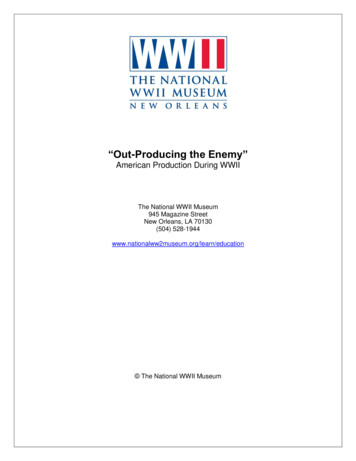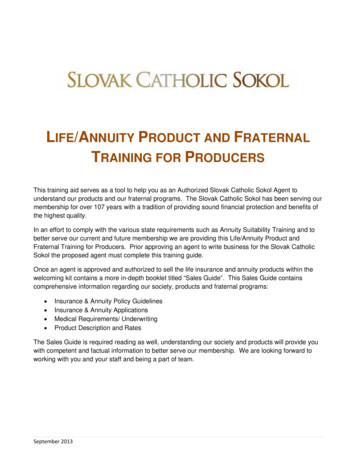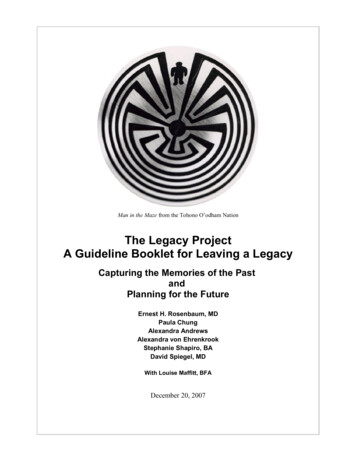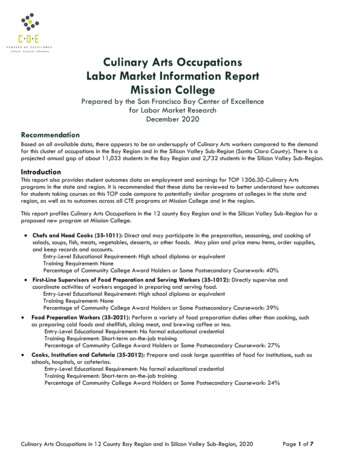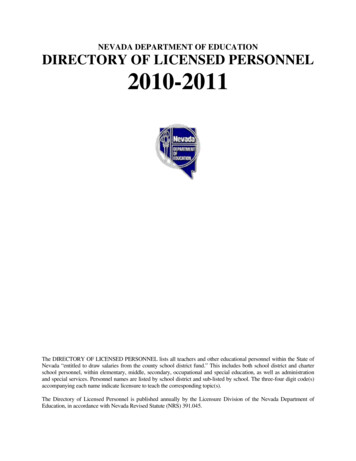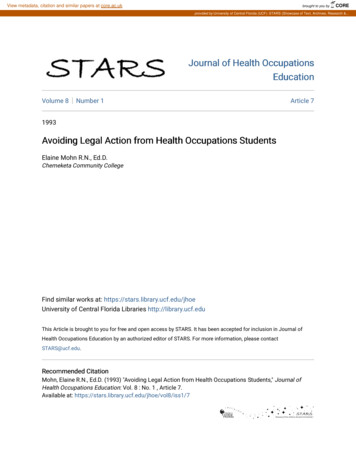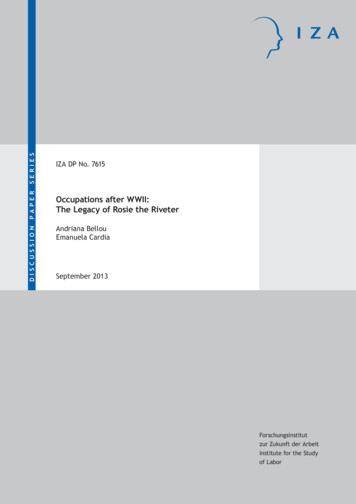
Transcription
SERIESPAPERDISCUSSIONIZA DP No. 7615Occupations after WWII:The Legacy of Rosie the RiveterAndriana BellouEmanuela CardiaSeptember 2013Forschungsinstitutzur Zukunft der ArbeitInstitute for the Studyof Labor
Occupations after WWII:The Legacy of Rosie the RiveterAndriana BellouUniversité de Montreal,CIREQ, CIRANO and IZAEmanuela CardiaUniversité de Montrealand CIREQDiscussion Paper No. 7615September 2013IZAP.O. Box 724053072 BonnGermanyPhone: 49-228-3894-0Fax: 49-228-3894-180E-mail: iza@iza.orgAny opinions expressed here are those of the author(s) and not those of IZA. Research published inthis series may include views on policy, but the institute itself takes no institutional policy positions.The IZA research network is committed to the IZA Guiding Principles of Research Integrity.The Institute for the Study of Labor (IZA) in Bonn is a local and virtual international research centerand a place of communication between science, politics and business. IZA is an independent nonprofitorganization supported by Deutsche Post Foundation. The center is associated with the University ofBonn and offers a stimulating research environment through its international network, workshops andconferences, data service, project support, research visits and doctoral program. IZA engages in (i)original and internationally competitive research in all fields of labor economics, (ii) development ofpolicy concepts, and (iii) dissemination of research results and concepts to the interested public.IZA Discussion Papers often represent preliminary work and are circulated to encourage discussion.Citation of such a paper should account for its provisional character. A revised version may beavailable directly from the author.
IZA Discussion Paper No. 7615September 2013ABSTRACTOccupations after WWII: The Legacy of Rosie the RiveterWWII induced a dramatic increase in female labor supply, which persisted over time,particularly for women with higher education. Using Census micro data we study thequalitative aspects of this long term increase through the lenses of the occupations womenheld after the war. Almost two decades after its end, we find that WWII had lasting, albeitcomplex but interesting effects on the occupational landscape. It led to a significant increasein the presence of young women, who were of working age at the time of the war, inmanufacturing and professional/managerial occupations, while it entailed a decrease in thepresence of older cohorts in clerical. Though differently, the effects surprisingly extended tothe next generation of women who were too young to be working at the time of the war. Forthis cohort, the increase was concentrated in clerical and manufacturing. The entry of thisvery young cohort in clerical jobs and the exit of the older, suggests within-gender crowdingout; the increased presence of both cohorts in manufacturing, that the legacy of the wartimeRosies permeated occupational choices.JEL Classification:Keywords:J24, J31, N42WWII, occupationsCorresponding author:Andriana BellouUniversité de MontréalDépartement de Sciences ÉconomiquesC.P. 6128 succursale Centre-villeMontréal, H3C 3J7CanadaE-mail: andriana.bellou@umontreal.ca
1. IntroductionThe general belief is that WWII had an important impact on the participation of women in thelabor market. Prior to the war, married women were discouraged from working and in many cases therewere policies in place not to hire or keep them once they married. These policies started to disappear inthe early 1940s and had become very uncommon by the 1950s (Goldin, 1991). With nearly 16 million ofmen drafted, the shift in labor supply due to them leaving the market created an important shortage ofmanpower. This, together with a sense of patriotic duty, led to an unprecedented entry of women in theworkforce not only to provide necessary services and goods, but also to contribute to war production.Despite this, the overall impact of the war on female labor market prospects remains unclear and has beenthe subject of scholarly controversy among historians. For some, like Chafe (1972), WWII was a“watershed” event that transformed the economic outlook of women. For others, like Campbell (1984), nosocial change was realized. WWII had no lasting effects, as - when men returned - many of the jobsoffered to women during the war were taken away and a significant portion of the wartime femaleentrants exited the market.It is only recently that economists have started studying the effects of the war on women’s laborsupply using individual micro data. The overall evidence concords that WWII increased the lattersubstantially (Goldin, 1991; Acemoglu, Autor and Lyle, 2004; Fernandez, Fogli and Olivetti, 2004), withits greatest impact on women who were high school graduates (Acemoglu et al., 2004). While Goldin(1991), using the Palmer Survey data until 1950, concludes that these effects were rather transitory, morerecently, Goldin and Olivetti (2013) show that long-run implications of WWII on women’s labor supplyalso exist, are substantial and driven (in short run as well as in long run) almost exclusively by the groupof women with at least a high school degree. These results seem to provide some support to the“watershed” view of WWII.If WWII was indeed a “watershed” event, it is reasonable to expect that it led not only to higheremployment but also possibly to significant gains in terms of the type of occupation women held, skilledversus unskilled, to reduced barriers to entry for married women and/or to a decrease in the gender2
earnings gap. One popular presumption is that after the war women left “Rosie the Riveter” occupationswhile they kept clerical, teaching and other “white-collar” jobs (Milkman, 1987; Kennedy, 1999; Goldin,1991, Goldin, 1994). 1 Since the majority of women with at least a high school degree were employed in“white-collar” occupations (Table 1b) and the war increased participation of this group, one might creditWWII for contributing to an expansion of female employment in professional/managerial and clericalsectors. In fact, between 1940 and 1960 women increased their presence in these occupations, whilemarkedly decreasing it in manufacturing. 2 However, these are average shares and may reflect seculartrends in place since the start of the century. If we disaggregate by age group (Table 1a), the picture thatemerges is different and suggestive of age-specific trends in manufacturing. 3 The share of all women 35to 54 years old employed in this sector (and likely treated by the war) increased over the two decades,while it decreased for women aged 18 to 34, most of them too young to be working during WWII. 4 Thesechanges could suggest that the war might have changed the distribution of women across occupations andpossibly, that women did not massively quit “Rosie the Riveter” jobs after the war. 51Using the Palmer survey, Goldin (1991) finds that about half of the wartime female entrants left the labor marketsometime after December 1944.2Bailey and Collins (2006, Table 2): 25.5% to 32.6% (clerical), 13.7% to 14.9% (professional/managerial) and22.2% to 17.2% (manufacturing). For these calculations the authors consider white women 18 to 64 years old at thecensus date who were in the labor force and reported an occupation. Their definition also includes women who wereunemployed at the survey week.3Henceforth, the terms “manufacturing” and “operatives” will be used interchangeably.4Our calculations in Table 1a are based on a sample of white women, born in the United States, who were employedat the survey date and reported an occupation. The reference population for our tabulations is the entire age-specificfemale population. See Section 3 for a justification of this choice. When we use the age-specific employed femalepopulation as an alternative reference group, we can replicate the aggregate statistics by occupation reported inBailey and Collins (2006). Once the same age decomposition is pursued, the decline in employment shares of the 18to 34 years old in manufacturing is even more pronounced and essentially drives the fall in operative employmentshares for the entire white 18 to 54 years old employed female population.5When war production started, there was resistance in hiring women. However, as early as the spring of 1941,Herman (p. 262) reports that articles in magazines like the American Machinist and Business Week were describingstories of “women being trained to handle even the most complex machinery”. The famous “Rosie the Riveter” waspainted by Norman Rockwell for the May 29 1943 cover of The Saturday Evening Post, with a riveting gun on herlap and her foot set on top of Mein Kampf, to inspire women to become wartime workers. “Rosie the Riveter”became the patriotic image of a working woman, created to encourage women to take up typical man manual jobssuch as riveting. Riveting was actually a high-skill occupation and Kennedy (1999) suggests that the most typicaljobs for women were low-skilled, such as welding.3
Such potentially important transformations may have taken place for several reasons. Womenwere drawn into the wartime economy in large numbers, occupied various positions, and presumablyaccumulated valuable experience and market skills. Some of these jobs were of “Rosie the Riveter”- type,but women also substituted for men in a wide array of “white-collar” occupations for which they hadqualifications but may have been previously discouraged from working in. These acquired skills and workexperiences, coupled with a possible gradual change in attitudes regarding the economic role of women,might have enhanced their opportunities post-war and strengthened their presence even in moretraditionally male-dominated sectors. 6 After the war, although many returning veterans may have takenback their old jobs, a significant share had interrupted their schooling and used G.I. Bill benefits to furthertheir education (Bound and Turner, 2002). This, together with war-related injuries, may have alsoextended the period women remained in the labor market. In addition, further complicating the impact ofthe war on labor markets, the GI Bill has been credited for increasing the educational attainment ofreturning men thereby changing their working potential in the market.As of now however, and to our knowledge, little is known about the long term impact of the waron the occupations women kept or more easily re-entered after the war ended. This paper aims atshedding light on this question, at unraveling the implications of the war on the occupational distributionof women who were of working age at the time. What was the legacy of “Rosie the Riveter” jobs? Whathappened to women who entered clerical occupations to replace men who joined the Armed Forces? Didthe war change the gender earnings gap in these occupations? Which occupations did married womenjoin? Did the war shape the occupational choices of younger generations of females, who were too youngto have entered the market prior to its conclusion?To attempt answering these questions, we exploit Census information on occupations between thepre and post-war periods. This data can provide important information, yet unused, that can help us gainsome insights on the qualitative impact of the war on the economic outlook of women. We use this6The expression “male-dominated” is used henceforth to characterize occupations with typically higher employmentshares of men relative to women. Operatives is one such example (also see Table 1b).4
information to examine whether the war made a significant difference in the type of occupations womenheld before and after this event. We focus on its permanent, long term effects on women’s occupationalpresence to allow sufficient time for the labor market to settle after the reintegration of veterans and forpotential shifts in social norms to influence the perception of employers towards female workers. Toachieve this, we compare changes within states in the presence of women in four major occupation groupsbetween 1940 (pre-war) and 1960 (post-war) using the share of 18 to 44 years old registered men whowere drafted or enlisted for the war as a measure of the decline in male labor supply induced by WWII.This identification strategy is akin to Acemoglu et al. (2004).We focus on two cohorts: women 35 to 44 and 45 to 54 years old, respectively, in 1960. The firstcohort was 17 to 26 in 1942, right after the Pearl Harbor attack and the U.S. declaration of war to Japan.This cohort includes a large share of women who had most likely completed high school and may havehad some college education; some of them may not have been married, had children or started working;many decisions had still to be made. The older cohort was 27 to 36 years old in 1942, more likely to bemarried, have children and have made choices about whether to work or not and in which occupations.According to Goldin and Olivetti (2013), WWII had lasting effects on the labor supply of both groups.Our results show that the two cohorts were permanently affected, albeit in different ways, withthe young cohort being the most significantly impacted. In states with higher mobilization rates, youngerwomen significantly increased their overall presence in “blue-collar” occupations, namely services andoperatives. Women with at least a high school degree increased their presence in “white-collar”professional/managerial occupations but, interestingly, also in operatives. This finding suggests that asignificant number of women, who entered traditionally male-dominated manufacturing jobs during thewar, did not leave them or more easily re-entered or entered them later on. Turning to the older cohort, thewar instead led to a substantial decrease in its share in clerical occupations. These results are robust acrossa wide array of specifications, including an instrumental variables strategy that uses as instrument formale mobilization rates the fraction of German-born males aged 13–44 in 1940.5
We extend our baseline analysis in three ways. First, we inquire whether the war shifted not onlythe absolute female representation across the four occupation groups between 1940 and 1960 but alsotheir presence relative to men. The results confirm the “positive” role of the war on female employmentin professional/managerial occupations: in high mobilization states, not only did women’s absoluteemployment shares increase but women also crowded-out men. Instead, the absolute increase in theirpresence in manufacturing is matched by a similar increase by men. This occupational change, whileconsistent with a gender-unbiased labor demand shift, could still be the result of a change in societalnorms towards females. In the older cohort, the dramatic exit of women from clerical occupations was,surprisingly, not accompanied by entry of male workers from the same age cohort. In fact, theemployment shares of the latter did not substantially change as a result of WWII. Finally, both older menand women increased their representation in services.Second, we inquire whether the baseline effects of the war on the occupational status of womenwho could have worked during WWII (35 to 54 years old in 1960), had lasting implications for muchyounger generations of females (18 to 29 years old in 1960), who were too young to work at the time. Wefind that, in high mobilization states, their presence increased in operative and clerical occupations butdeclined in the services. No significant changes were observed in the group of professional/managerialjobs. In contrast to the generation of 35 to 44 year olds, the increased presence of the youngest cohort inoperatives was exclusively driven by the less educated women. Interestingly, when we study the overalleffect of the war on the change in total white female employment of 18 to 54 years old women in the fouroccupation categories, we find a null impact on clerical, services and professionals. These results indicatethat, in these three occupation groups, the war likely induced redistributions within and acrossoccupations and cohorts of workers without substantially shifting total female employment shares.Nevertheless, total female employment in operatives was significantly expanded in high draft rate areas.This suggests that some wartime Rosies did not permanently exit the market after the war and that theseeffects were extended to the youngest cohorts.6
Finally, we examine whether the war led to improvements in the male-female wage gap acrossoccupations. We find evidence suggestive of a war-related narrowing of this wage difference in sporadiccases. Most notably a closing of the gap was realised in manufacturing and this applied to both older andyounger cohorts of women.The remainder of the paper is organized as follows. Section 2 presents the data and descriptivestatistics and Section 3, the econometric methodology. Section 4 presents our main results and theirrobustness to alternative specifications. Section 5 discusses the role of occupational crowding-outbetween male and female workers, the long term implications of WWII for gender wage differentials aswell as for the occupational choices of younger generations of women, who could not have worked duringthe war. Finally, Section 6 concludes with an overall assessment of our findings.2. Data and Descriptive StatisticsOur main data sources are the 1940 and 1960 1 percent IPUMS files (Ruggles et al. 2010).Following Goldin and Olivetti (2013), we restrict the analysis to white women, born in the United Statesand not residing in institutional group quarters. To insure greater exogeneity, as in Fernandez et al. (2004)as well as in Goldin and Olivetti (2013), we use the state of birth as the reference state to establish a linkbetween the mobilization rate of men and women’s occupational presence. We focus on two cohorts:women 35 to 44 and 45 to 54 years old respectively in 1960. These women were 15 to 34 years old in1940 and hence were directly affected by the war as they could have entered the labor market in 1942 justafter the official entry of the U.S. in the war. As in Acemoglu et al. (2004), Fernandez et al. (2004) andGoldin and Olivetti (2013), we employ state-level WWII mobilization rates for registered men 18 to 44years old to measure the effect of the war. The latter reflects cross-state variation in the reduction in thelabor supply of men who were drafted to serve in the Armed Forces. We examine the effects of the waron four occupation groups, which altogether represent almost 90% of all white, employed, 35 to 54 �), clerical, operatives and services. We also consider two aggregates: “white-7
collar” for the first two occupations and “blue-collar”, for the last two.7 Finally, since Acemoglu et al.(2004) and Goldin and Olivetti (2013) show that WWII predominantly affected the short and long runlabor supply patterns of women in the top half of the education distribution, we also report estimatesconditional on having at least a high school diploma or less than that.Tables 1 and 2 begin the analysis by presenting descriptive statistics for the two sample years.Table 1a reports participation shares across the four occupation groups and by age, while Table 1bpresents a similar decomposition by educational attainment for the two cohorts of interest. Shares aretabulated for white women as well as for the entire white population in the appropriate age and educationgroups. First of all, as a general observation, most men and women who are in professional/managerial orclerical occupations have at least a high school degree, while their majority in services and operatives iswithout a high school diploma. Second, Table 1b indicates that the share of men and women working inprofessional/managerial occupations declined between 1940 and 1960, while their share in clericaloccupations increased by more than 20%. Instead, the proportion of women working inprofessional/managerial jobs rose while in clerical nearly doubled. The share of operatives in the totalpopulation increased sharply over the two decades, by 94% and 69%, for men and women combined anddepending on whether they were or were not high school graduates, respectively. For women, the increasewas even more dramatic, higher than 120% for all educational levels. The service sector also expanded,though the changes were much less dramatic than for operatives; here too, women with less than highschool outpaced men importantly. In subsequent sections, we formally study whether these occupationalshares were systematically influenced by the incidence of the war, while accounting at the same time forpotentially confounding aggregate trends.Table 2 follows Acemoglu et al. (2004) in dividing states into three groups on the basis of WWIImobilization rates and calculating the means of female occupation shares in each group in 1940 and 1960.This exercise serves to detect whether there is any systematic correlation between WWII mobilization7We did not include occupations that were not present in the census in both decades. One example is accounting,which was therefore excluded.8
rates and pre-WWII (1940) female occupational shares. The existence of such a relationship wouldthreaten the validity of our identification strategy detailed in the following section. As the raw datatabulations in Table 2 reveal, there are no substantial differences in occupational participation across low,medium and high mobilization states for neither of the two cohorts of women. To control for possible preexisting trends that could invalidate our identification strategy (detailed in the following section), weinclude as covariates the shares of men working in each of the considered occupations in 1940.3. Econometric SpecificationTo examine the impact of WWII on women’s occupations we estimate models of the followingstructure that pools 1940 and 1960 data:𝑦𝑖𝑗𝑠 𝛽1 𝑀𝑜𝑏𝑠 𝑑1960 𝛽2 𝑑1960 β3 𝑋𝑠 𝑑1960 𝛽4 𝐷𝑖𝑗𝑠𝑡 𝜀𝑖𝑗𝑠(1)The dependent variable is an indicator for the presence of woman i of cohort j in occupation s. It equals 1if the woman is working in occupation s at the census date and 0, if she is not working in that occupationor not employed, nor looking for a job. In other words, we focus on occupational participation as a shareof the total cohort-specific female population rather than the employed population. We do that becausewe believe that the decisions to enter the labor market during the war and to enter a given occupationmight have been very closely linked. 8 In an alternative specification, we also consider occupation sharesas a function of the total age-relevant female employed population.Mob is the mobilization rate of men in the woman’s state of birth. The coefficient of interest is 𝛽1and measures whether states with higher mobilization during WWII experienced greater long termchanges in female occupation shares. X is a vector of 1940 state covariates: the share of males who arefarmers, the share of non-white males and male average education. These covariates, identified byAcemoglu et al. (2004), are included in order to account for confounding factors at the state level thatmight be correlated with mobilization rates as well as the outcome variables. Since the dependent variable8Mulligan (1998), using data from a March 1944 national longitudinal survey conducted by the BLS, shows thatindustrial or occupational switches by women between December 1941 and March 1944 were fairly unimportant.Instead sizeable shifts from out of the labor force and into particular occupation groups took place outnumberingany switches between broadly defined industries.9
is female occupational participation, we enrich the set of aforementioned covariates with the 1940 shareof males employed in defense-related industries as well as the 1940 share of men working in the sameoccupation group as in the outcome variable. This is to account for initial cross-state differences in thedemand for female labor in occupations/industries directly related to the war and to the occupation groupof interest. All aggregate controls are matched on the basis of the individual’s state of birth and areinteracted with a 1960 year dummy. D is a vector of individual characteristics which includes dummiesfor age, state of birth, and state of residence in order to account for cross-state migration. 𝑑1960 is adummy for the year 1960 and any individual covariate, with the exception of state effects, is interactedwith this time effect. Year effects control for unobservable factors that can systematically influenceoccupational shares uniformly across cohorts and states. Finally, sample line weights are employed in allcalculations and standard errors are clustered by state of birth and census year.The identification strategy we employ essentially relies on variation in draft rates andoccupational participation within states over time in order to gauge the effect of WWII on the presence ofwomen across the occupational distribution. This methodology controls for any time invariant statecharacteristics that might be systematically correlated with mobilization rates as well as the outcomes ofinterest. The identifying assumption is that conditional on all the covariates as well as state and year fixedeffects, mobilization rates are random. The lack of a systematic relationship between mobilization ratesand pre-war female occupational outcomes suggested by the statistics presented in Table 2, as well as theinclusion in the model of important pre-war state demographic characteristics, provide some confidencein favor of the causal interpretation of our estimates. As will be discussed in the next section, we alsoperform further tests to check the robustness of the main findings including an instrumental variablesapproach. Following Acemoglu et al. (2004), we employ as instrument the 1940 fraction of German-bornmen 13 to 44 years old in a given state. Men of German nationality living in the U.S in 1940 were morelikely to receive deferrals due to concerns of sending them to fight against their country of origin. Thisvariable produces a strong first stage in all our regressions with large F-statistics. This, along with the factthat there is no particular reason why German nationality would affect female labor supply or the10
occupations American women worked in, makes this variable a plausible source of potentially exogenousvariation.4. Occupations and WWIIWe report OLS estimates of the impact of WWII in Tables 3 and 4. We present three sets ofresults: for the entire sample of women and by their level of educational attainment: high school graduateor more vs. less than high school. Columns 1, 2 and 3 display estimates when the dependent variable isoccupational participation, that is when employment shares are calculated using as reference populationall females in the relevant cohort. Column 4 reports estimates when the reference group is the employedcohort-specific population. 9 In the estimates reported in the second column and onwards, we also controlfor the share of males employed in defense industries and for the share of men employed in the sameoccupation as that described by the dependent variable. 10 These two covariates are introduced to accountfor pre-existing sector-specific occupational trends. Employment in 1940 in defense-related industriescould reflect pre-existing state defense spending differences. During the war, the U.S. massivelyconverted its industrial base to produce armament and war related goods. This production representednearly two thirds of all Allied military equipment used in WWII (Herman, 2012). It is possible, then, thatthe regions experiencing this substantial transformation relied differentially on female workforce forproduction compared to the less affected areas. Moreover, given the nature of the production in theseareas it is plausible that women were directed towards more “blue-collar”, manufacturing-type jobs. Theaugmented model presented in Column 2 will serve as our benchmark in Tables 3 and 4.Finally, Column 3 replicates estimates of Column 2 focusing exclusively on a sample of whitewomen who were married in the census years. Distinguishing heterogeneous effects across the educationdistribution and by marital status is important given the findings in the recent literature that married and9In this case we also estimated models accounting for non-random sample selection into the working sample usingthe Heckman correction procedure. We used state of birth unemployment rate interacted with a 1960 dummy as apredictor of participation in the first stage. Our main conclusions pertaining to Tables 3 and 4 and detailed in thecurrent section remained qualitatively robust. Results are available upon request.10To define defense industries we follow Acemoglu et al. (2004). Defense industries correspond to IPUMS 1950industry codes 326–88.11
better educated women altered the most their short and long run labor supply in response to the war.Tables 3 and 4 also report estimates of the effect of WWII on the presence of women in “white” and“blue-collar” occupations, respectively. These groups include female workers in professional/managerialand clerical jobs (“white-collar”) as well as in operatives and services (“blue-collar”).The results in Table 3 suggest that the younger cohort with at least a high school diplomasignificantly increased its presence not only in professional/managerial occupations but also inmanufacturing. States with a 10 percentage point higher mobilization rate experienced an increase in theshare of high school graduates in professional/managerial or operative jobs by 3 and 2.6 percentage pointsrespectively. This is a 25 and a more than 100 percent increase, respectively, relative to the 1940 averagesfor these groups.11 These increases are
lap and her foot set on top of Mein Kampf, to inspire women to become wartime workers. "Rosie the Riveter" became the patriotic image of a working woman, created to encourage women to take up typical man manual jobs such as riveting. Riveting was actually a high-skill occupation and Kennedy (1999) suggests that the most typical jobs for women were low-skilled, such as welding. 4 Such .


